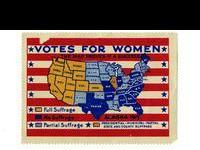*This blog is the thirteenth in a series by Sarah Sharp, Global Educator for World Heritage Philadelphia.
Introduction
During the late 1800s and early 1900s in Philadelphia, across the United States and in some regions of the globe, activism and advocacy on behalf of women’s issues increased. Political access, working conditions, and reproductive matters as well as social conditions, and educational and employment opportunities were among the most notable concerns. As we view Philadelphia in the present era, students and their teachers can find numerous ways to compare and contrast situations involving women’s involvement and leadership across all aspects of society. Young Philadelphians may investigate what modern activism and advocacy are like, and how both actually occur. Youth can imagine what they wish to see changed in the City the 21st century as they look outward from their own lives into our shared past, present, and beyond.
For Women's History Month, we offer this blog in three parts over the month: Social Issues, Economic Issues, and Political Issues.
Political Issues
As we consider the various dimensions of Philadelphia’s political life in the late 1800s and early 1900s, we find key local, state, and international activities related to suffrage in particular. The fact that male voters across the country ratified the Nineteenth Amendment to the US Constitution in 1920, which guaranteed the right to vote to all citizens regardless of gender may be the most well-known event involving women’s roles in American political life in this era. Yet, the story of that achievement has major local dimensions, too. Susan B. Anthony (1820-1906) was in Philadelphia during the 1876 Centennial, working at the National Woman Suffrage Association (NWSA) headquarters. Others, such as Rosie Gratz (1781-1869), Elizabeth Cady Stanton (1815-1902), Caroline Katzenstein (1888-1968), and Alice Paul (1885-1977) were all part of the suffrage campaign in the Philadelphia area for decades. Dora Kelly Lewis (1882-192), among others were members of the Philadelphia Equal Franchise Society, and later, the National American Woman Suffrage Association (NAWSA). Racial divides were part of story regarding suffrage efforts in terms of African Americans and Native Americans, nationally and in Philadelphia. Not all white women supported Black women getting the vote.
- What is the major heritage of women’s suffrage for Philadelphia’s youth in our own time when voting in all elections is at a low point?
- How would students compare and contrast the events, platform, and leadership of the 2106 National Democratic Convention held in Philadelphia with conventions with the suffrage activities from 100 years earlier?
- How is race still part of the gender equality issue?
- How would students reflect on Hillary Rodham Clinton’s presidential candidacy given this information about women’s political activism and efforts to gain suffrage?
- How do the recent national women’s marches which have occurred in recent years across the country fit into the story of women’s activism in the U.S.? What has been the role of Philadelphia women in these events?
Finally, we certainly see Philadelphia women’s concerns echoed in the international political realm in this era, Several European countries celebrated the first International Women’s Day on March 19, 1911 lifting up women’s suffrage, work life concerns, and vocational training, among other matters. Over 1,000 American and European women travelled to the first International Congress of Women, which occurred at The Hague on April 28, 1915. Out of this gathering came the Women’s International League for Peace and Freedom ,which still has a presence in Philadelphia as well as elsewhere in the United States. Numerous organizations and businesses commemorate International Women’s Day, as well as Women’s History Month each year in Philadelphia, including the National Constitution Center and the Historical Society of Pennsylvania.
- Students can learn about activities of the International Women’s Club of Philadelphia through http://www.iwcp.org/
- Students can investigate the history of International Women’s Day through the United Nations, and consider how they would like to celebrate it here in Philadelphia. http://www.un.org/events/women/iwd/2009/history.shtml

